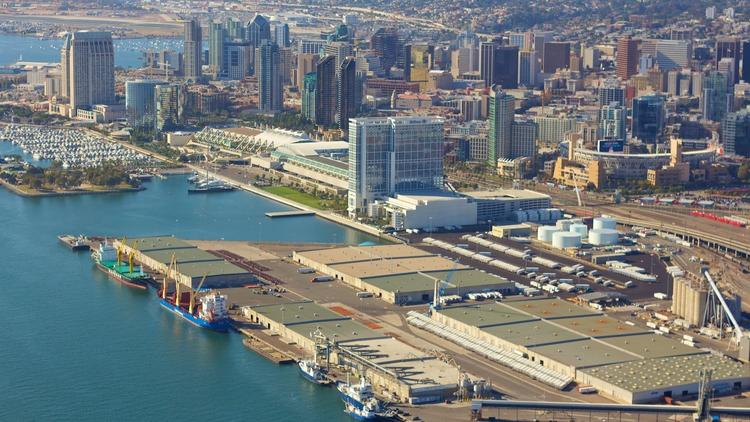The 10th Avenue Marine Terminal, a vestige of San Diego’s drive in the 1950s to be a powerhouse industrial port, is retooling for a change in market conditions.
The San Diego Unified Port District voted last week to spend $32.7 million on various improvements over the next few years with the hope that it can generate $62 million in extra revenue. The federal government has pledged $10 million toward the effort.
Construction is planned to begin in June for completion in March 2020.
“This is a huge day for the port of San Diego to be able to move forward with this plan,” said incoming Chairman Robert “Dukie” Valderrama.
He noted the planned reduction in pollution levels by citing a personal memory of his family neighbors’ exposure to unhealthy air conditions from nearby industrial and traffic conditions in National City.
“My theme is win-win-win,” he said, referring to the port, tenants and the surrounding community. “We’ve got to make decisions predicated on helping the community.”
The board approved an environmental impact report and a coastal development permit after reducing the growth projections to meet reduced pollution targets.
The terminal improvements are projected to increase cargo from 1 million metric tons in 2014 to 4.7 million metric tons by 2035. An earlier projection showed an increase to 6.2 million metric tons.
The cargo would come in the form of dry and liquid bulk shipments, refrigerated food products and multipurpose general cargo. Multipurpose general cargo would rise the most, from 85,131 to 733,050 metric tons.
Barrio Logan residents and Environmental Health Coalition officials lauded the port for reducing the growth targets but asked the port to go even further by helping pay for air filtration and solar energy systems at Perkins Elementary School.
“There are impacts from this project and we understand that, the community understands that,” said EHC Executive Director Diane Takvorian. “But we have always been supportive of economic impacts of the port.”
The staff report projects 524 permanent jobs and 50 temporary jobs over the 33-month construction period.
The first phase of the terminal’s new master plan, costing $24 million, calls for:
Demolition of transit sheds 1 and 2 on the west side of the 96-acre terminal
A new area for temporary equipment storage.
Completion of several rail improvements.
Future phases would involve a 100,000-square-foot dry-bulk storage container; improved conveyor systems; demolition of Warehouse C in the middle of the terminal; and five new 270-foot gantry cranes.
To reduce some environmental impacts, the plan calls $8.6 million in mitigation costs, including enough parking to accommodate all terminal workers rather than allowing any spillover into neighboring Barrio Logan streets; buying 36 pieces of freight equipment that generate little if any toxic emissions; and installing hoods on visiting freighter exhaust pipes to capture emissions when the freighters cannot plug into shore power lines.
Commissioner Rafael Castellanos said his family suffered from asthma problems while growing up in a mining town. He welcomed a safer, less polluting industrial facility on San Diego Bay.
“I’m happy to see us going in a different direction,” Castellanos said. “This is not only our Prius, it is our Tesla. It’s about a greener and cleaner and going faster … It should be a model for regional planning.”
Commissioner Dan Malcolm alluded to earlier proposals to build a football stadium on or above the terminal, an idea the port vigorously opposed.
“It was our obligation to fight for the terminal and all the jobs for the maritime industry,” Malcolm said.
Although the plan capped expansion to 2035, it leaves open the possibility of greater growth if technology and pollution controls advance enough to make it acceptable.
The terminal was planned in the 1950s to replace a garbage dump and burn site.
Cargo in the 1960s included animal hides, livestock, hay and bales of cotton, said Joel Valenzuela, the port’s director of maritime operations. Those import and export items required covered warehouses, whereas today’s cargo coming through San Diego needs open areas for handling and processing.





